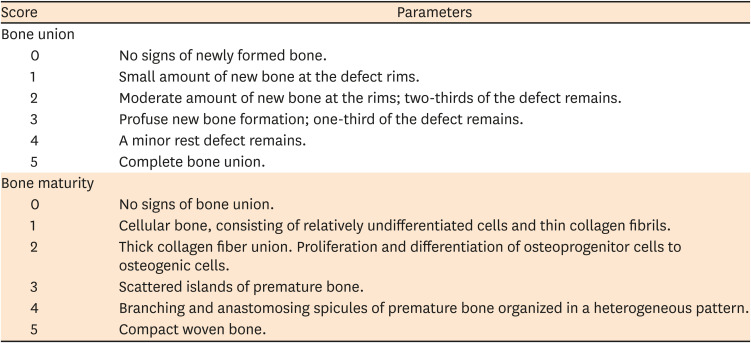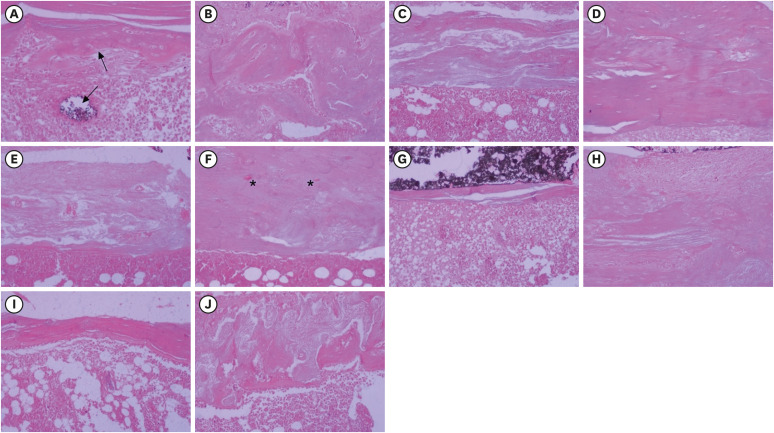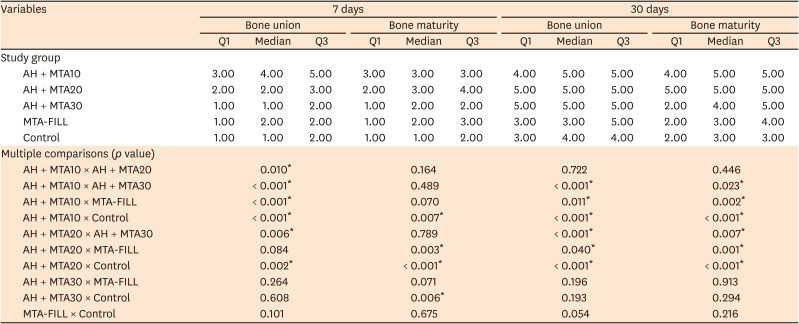1. Lim M, Jung C, Shin DH, Cho YB, Song M. Calcium silicate-based root canal sealers: a literature review. Restor Dent Endod. 2020; 45:e35. PMID:
32839716.

2. Fonseca DA, Paula AB, Marto CM, Coelho A, Paulo S, Martinho JP, Carrilho E, Ferreira MM. Biocompatibility of root canal sealers: a systematic review of
in vitro and
in vivo studies. Materials (Basel). 2019; 12:4113–4117.

3. Al-Haddad A, Che Ab Aziz ZA. Bioceramic-based root canal sealers: a review. Int J Biomater. 2016; 2016:9753210. PMID:
27242904.

4. Kaur A, Shah N, Logani A, Mishra N. Biotoxicity of commonly used root canal sealers: a meta-analysis. J Conserv Dent. 2015; 18:83–88. PMID:
25829682.

5. Jafari F, Jafari S. Composition and physicochemical properties of calcium silicate based sealers: a review article. J Clin Exp Dent. 2017; 9:e1249–e1255. PMID:
29167717.

6. Torabinejad M, Hong CU, McDonald F, Pitt Ford TR. Physical and chemical properties of a new root-end filling material. J Endod. 1995; 21:349–353. PMID:
7499973.

7. Torabinejad M, Parirokh M, Dummer PMH. Mineral trioxide aggregate and other bioactive endodontic cements: an updated overview - part II: other clinical applications and complications. Int Endod J. 2018; 51:284–317. PMID:
28846134.

8. Assmann E, Böttcher DE, Hoppe CB, Grecca FS, Kopper PM. Evaluation of bone tissue response to a sealer containing mineral trioxide aggregate. J Endod. 2015; 41:62–66. PMID:
25447498.

9. Jung S, Sielker S, Hanisch MR, Libricht V, Schäfer E, Dammaschke T. Cytotoxic effects of four different root canal sealers on human osteoblasts. PLoS One. 2018; 13:e0194467. PMID:
29579090.

10. Kebudi Benezra M, Schembri Wismayer P, Camilleri J. Interfacial characteristics and cytocompatibility of hydraulic sealer cements. J Endod. 2018; 44:1007–1017. PMID:
29398087.

11. Cintra LTA, Benetti F, de Azevedo Queiroz ÍO, Ferreira LL, Massunari L, Bueno CRE, de Oliveira SHP, Gomes-Filho JE. Evaluation of the cytotoxicity and biocompatibility of new resin epoxy-based endodontic sealer containing calcium hydroxide. J Endod. 2017; 43:2088–2092. PMID:
29032822.

12. de Oliveira RL, Oliveira Filho RS, Gomes HC, de Franco MF, Enokihara MM, Duarte MA. Influence of calcium hydroxide addition to AH Plus sealer on its biocompatibility. Oral Surg Oral Med Oral Pathol Oral Radiol Endod. 2010; 109:e50–e54. PMID:
20123371.

13. Falcão LF, Silva PR, Falcão DF, Pinto LSS, Falcão CAM. Evaluation of the biocompatibility of AH Plus sealer associated to Portland cement or MTA. Subcutaneous study in rats. Rev Interd. 2018; 11:1–11.
14. Garcia LF, Huck C, Scardueli CR, de Souza Costa CA. Repair of bone defects filled with new calcium aluminate cement (EndoBinder). J Endod. 2015; 41:864–870. PMID:
25720982.

15. Falcão CA, Lima EM, Júnior JDM, Freitas SA, Veras ESL, Moura LK, Falcão LF. Plus adhesiveness assessment associated with mineral trioxide aggregate in different proportions (push-out test). J Contemp Dent Pract. 2018; 19:1444–1447. PMID:
30713171.
16. Hedner E, Linde A. Efficacy of bone morphogenetic protein (BMP) with osteopromotive membranes--an experimental study in rat mandibular defects. Eur J Oral Sci. 1995; 103:236–241. PMID:
7552955.

17. Delfino MM, Guerreiro-Tanomaru JM, Tanomaru-Filho M, Sasso-Cerri E, Cerri PS. Immunoinflammatory response and bioactive potential of GuttaFlow bioseal and MTA Fillapex in the rat subcutaneous tissue. Sci Rep. 2020; 10:7173. PMID:
32346066.

18. Sousa Filho JL, Moreira KMS, Amaral GCLS, Fortunato CFP, Dias IVA, Falcão CAM. Radiopacity of AH Plus endodontic sealer plus MTA and Portland cement. Dental Press Endod. 2018; 8:18–21.
19. Sarkar NK, Caicedo R, Ritwik P, Moiseyeva R, Kawashima I. Physicochemical basis of the biologic properties of mineral trioxide aggregate. J Endod. 2005; 31:97–100. PMID:
15671817.

20. Costa F, Sousa Gomes P, Fernandes MH. Osteogenic and angiogenic response to calcium silicate–based endodontic sealers. J Endod. 2016; 42:113–119. PMID:
26577874.

21. Mestieri LB, Zaccara IM, Pinheiro LS, Barletta FB, Kopper PMP, Grecca FS. Cytocompatibility and cell proliferation evaluation of calcium phosphate-based root canal sealers. Restor Dent Endod. 2019; 45:e2. PMID:
32110532.

22. Salles LP, Gomes-Cornélio AL, Guimarães FC, Herrera BS, Bao SN, Rossa-Junior C, Guerreiro-Tanomaru JM, Tanomaru-Filho M. Mineral trioxide aggregate-based endodontic sealer stimulates hydroxyapatite nucleation in human osteoblast-like cell culture. J Endod. 2012; 38:971–976. PMID:
22703663.

23. Saraiva JA, da Fonseca TS, da Silva GF, Sasso-Cerri E, Guerreiro-Tanomaru JM, Tanomaru-Filho M, Cerri PS. Reduced interleukin-6 immunoexpression and birefringent collagen formation indicate that MTA Plus and MTA Fillapex are biocompatible. Biomed Mater. 2018; 13:035002. PMID:
29242419.

24. Scelza MZ, Campos CA, Scelza P, Adeodato CS, Barbosa IB, de Noronha F, Montalli V, Napimoga M, de Araújo VC, Alves GG. Evaluation of inflammatory response to endodontic sealers in a bone defect animal model. J Contemp Dent Pract. 2016; 17:536–541. PMID:
27595718.

25. Almeida LH, Gomes APN, Gastmann AH, Pola NM, Moraes RR, Morgental RD, Cava SS, Felix AOC, Pappen FG. Bone tissue response to an MTA-based endodontic sealer, and the effect of the addition of calcium aluminate and silver particles. Int Endod J. 2019; 52:1446–1456. PMID:
31034099.







 PDF
PDF Citation
Citation Print
Print



 XML Download
XML Download